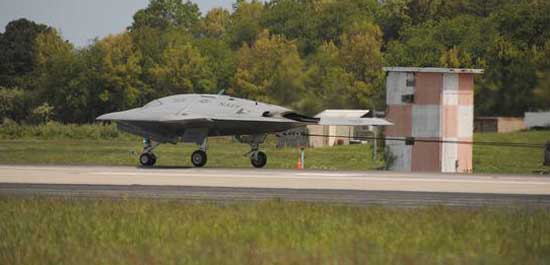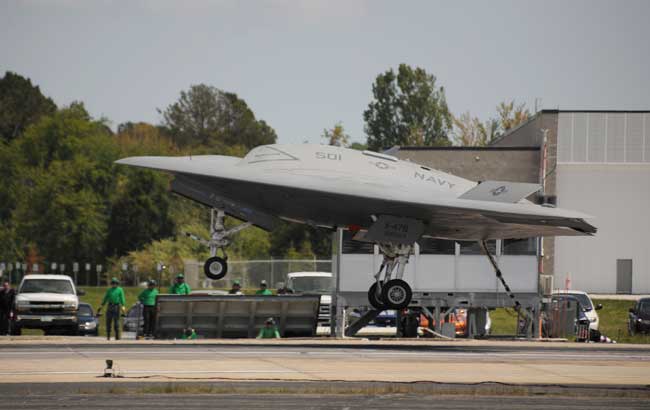
“Landing an unmanned aircraft on an aircraft carrier will be the greatest singular accomplishment for the UCAS demonstration and will serve as the culmination of over a decade of Navy unmanned carrier integration work”, said Capt. Jaime Engdahl, Navy UCAS program manager. Photo: US Navy
The U.S. Navy’s X-47B Unmanned Combat Air System (UCAS) demonstrator performed its first arrested landing at Patuxent River, Naval Air Station in Maryland, on May 4. The landing using arresting gear was a key step in maturing the system for its upcoming carrier-based tests later this month. The X-47B is scheduled to begin sea-based carrier flight testing on the USS George H.W. Bush (CVN 77). These tests will include launching from the carrier deck via catapult and, potentially completing landings aboard. Defense-Update reports.
“Landing an unmanned aircraft on an aircraft carrier will be the greatest singular accomplishment for the UCAS demonstration and will serve as the culmination of over a decade of Navy unmanned carrier integration work”, said Capt. Jaime Engdahl, Navy UCAS program manager. “Shore based arrested landing testing here at NAS Patuxent River is our final check that the X-47B can meet that objective.”
During Saturday’s test, the X-47B used a tailhook on the aircraft to catch a carrier representative cable, known as the MK-7 arresting gear, to quickly stop the aircraft. This is known as an arrested landing, the type of recovery required aboard aircraft carriers. The MK-7 arresting gear is an underground installation of actual carrier equipment that accommodates structural tests and aircraft/arresting gear compatibility studies with all models of U.S. Navy carrier aircraft.
“Shore-based testing allows our combined Navy/Northrop Grumman team to control test conditions before taking the aircraft to the ship,” said Matt Funk, Navy UCAS test team lead. “We are gradually building up to the maximum load conditions we expect to see during an arrested landing aboard an aircraft carrier.”
“The entire system has performed very well across a large set of shore-based testing events including aircraft performance, flying qualities, navigation performance, catapult launches, and precision landings designed to stress system operation,” Engdahl said. “Our final carrier-landing software simulation shows excellent performance, flight test results are very good, and we are confident the X-47B will perform well on the ship.”
The X-47B is a tailless, autonomous aircraft designed with unique features for an unmanned aircraft, such as carrier suitable landing gear and structure.While the X-47B itself will not be used for operational use, the UCAS-D program is developing a concept of operations and demonstrating technologies for use in follow-on unmanned carrier based aircraft programs.
“This actual demonstration of the X-47B unmanned carrier operations is a first, essential step toward developing a carrier-based unmanned system for the U.S. Navy,” said Rear Adm. Mat Winter, who leads the Program Executive Office for Unmanned Aviation and Strike Weapons. “A carrier-based unmanned aircraft will increase carrier strike group relevance, provide opportunities for training and readiness cost avoidance and enable our future forward deployed carrier air wings to provide continuous intelligence, surveillance and reconnaissance capability.”
Source: Defense-Update

“Shore-based testing allows our combined Navy/Northrop Grumman team to control test conditions before taking the aircraft to the ship,” said Matt Funk, Navy UCAS test team lead. “We are gradually building up to the maximum load conditions we expect to see during an arrested landing aboard an aircraft carrier.” Photo: US Navy
No comments:
Post a Comment